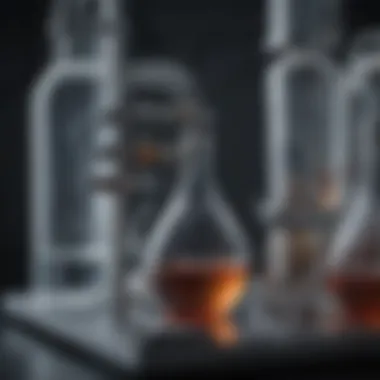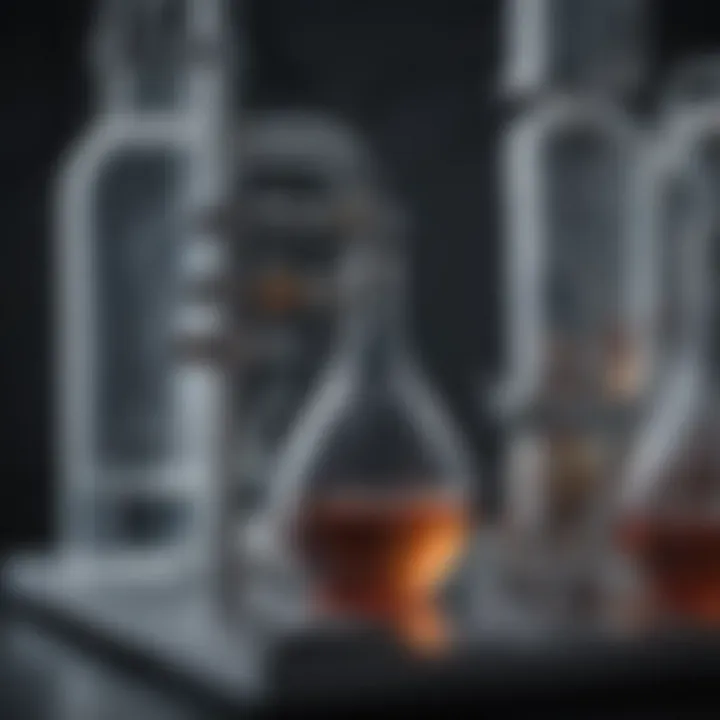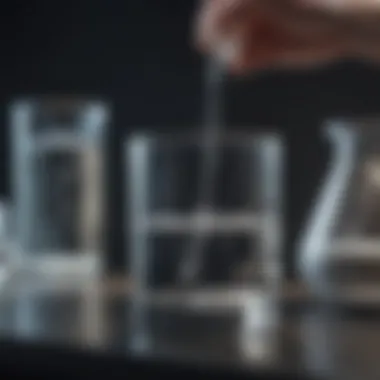Understanding Laboratory Water Distillation Units


Intro
As the heartbeat of many scientific experiments, water quality can't be overlooked. The clarity and purity of the water used in laboratories can greatly affect the outcomes of precious research. Among the various techniques to guarantee high-quality water, water distillation units have established themselves as an essential tool in laboratories. These units not only provide clean water but also play a significant role in maintaining consistency in experiments.
This article navigates through the complexities associated with water distillation in laboratory settings. From the architecture of these devices to their operating procedures, our aim is to equip students, researchers, educators, and professionals with the knowledge necessary to make informed decisions in their respective fields. By the end of this exploration, readers will grasp the importance of water distillation, learn to select the right unit, and understand how to maintain it in peak condition.
Research Context
Background and Rationale
Water has always been a critical component in laboratory practices, serving as a solvent and a medium for countless chemical reactions. However, the presence of impurities can lead to unexpected reactions, yielding skewed results. Hence, the development of water purification technologies is a response to the ever-growing demand for improved experimental conditions. Water distillation units have emerged not merely as appliances but rather as vital instruments designed to refine water to the highest purity levels.
The rationale behind an in-depth examination of these distillation units lies in the need for rigorous standards in laboratories. Correspondingly, understanding their principles and operational functionalities will empower laboratory personnel to uphold these standards, enhancing the overall reliability of scientific investigations.
Literature Review
The discourse surrounding water distillation has made substantial progress over the years. Notably, earlier studies focused heavily on the chemical principles underlying distillation. Papers such as those by Smith and Johnson (2015) outlined fundamental methodologies and common pitfalls associated with water distillation processes. Modern explorations complement these findings by shifting towards practical applications and innovations in design.
Research varies from investigating the effectiveness of specific distillation methods to the assessment of new technologies that could render water purification more efficient. Furthermore, numerous industry reports and articles from professional organizations emphasize the need for stringent quality control measures during the distillation process. As such, a synthesis of these findings serves to illustrate the growing importance and complexity of water distillation systems in laboratories today.
Methodology
Research Design
An effective understanding of water distillation culminates from a multi-faceted research design that incorporates both qualitative assessments and quantitative analysis. This dual approach allows for examining the functionality and effectiveness of various units employed in laboratory settings.
Data Collection Methods
To gather relevant data, several methodologies have been employed. These include:
- Interviews with experts in laboratory practices to gain insights into common challenges faced when using distillation units.
- Surveying laboratory staff across diverse disciplines to quantify satisfaction levels and operational efficiency of different commercial units used in practice.
- Field studies where actual distillation units are observed in use, providing direct insight into real-world applications and common operational issues.
To conclude, the integration of these methodologies paints a holistic picture of water distillation units, their functionality, and their broader implications for laboratory work.
Prologue to Water Distillation
Water distillation stands as a cornerstone in various laboratory settings, playing a pivotal role in ensuring the quality and purity of water used in experiments and analyses. It serves as a crucial process, particularly in fields like chemistry, biology, and environmental science, where even the slightest impurity can skew results and lead to erroneous conclusions. Understanding this subject is essential for both novices and seasoned professionals in their respective disciplines.
The importance of water distillation lies not just in its ability to purify water but also in its influence on the consistency of experimental outcomes. Distilled water, being devoid of dissolved minerals and contaminants, allows researchers to have precise control over variable conditions in their experiments. This makes water distillation units indispensable tools in laboratories, whether for routine analyses or specialized research.
Furthermore, water distillation is characterized by its simplicity and adaptability. Despite the complex mechanisms involved, the fundamental principles can be grasped with relative ease, making this technology accessible for a wide range of users.
Definition and Importance
Water distillation is essentially the process of separating components in a liquid through the selective evaporation and condensation of water. This technique relies on the differences in boiling points between water and various impurities, allowing for the effective removal of contaminants. Distillation transforms water into its gaseous state when heated, and as it condenses, the resulting liquid is often of very high purity. The significance of this process cannot be overstated, especially in laboratory environments where distilled water's purity is paramount for accurate and reliable testing.
The benefits of utilizing distilled water in laboratories can be outlined as follows:
- Enhanced Accuracy: By using distilled water, researchers can avoid variables introduced by tap water or other sources, ensuring more reliable data.
- Longer Equipment Lifespan: Using distilled water helps prevent mineral buildup in sophisticated instruments, prolonging their operational life.
- Regulatory Compliance: Many scientific protocols and standards specify the use of distilled water, making its availability critical for regulatory adherence.
Historical Context
The history of water distillation dates back centuries, with roots tracing to ancient civilizations. Evidence suggests that the Babylonians and Egyptians utilized primitive forms of distillation as far back as 2000 BC. Over time, this technique has evolved significantly.
In the Middle Ages, distillation gained prominence in alchemical practices. Alchemists experimented with the properties of liquids, discovering the process of distillation not only for the purification of water but also for extracting essences, alcohols, and essential oils from plants. These early experiments laid foundational principles for modern-day distillation techniques.
With the advent of the Industrial Revolution, advancements in scientific understanding and technology led to more sophisticated and efficient water distillation units. Today, these units can range from small, bench-top systems suitable for individual labs to large-scale industrial setups designed to meet the demands of extensive research facilities.
As water scarcity and quality have become increasingly critical issues, the evolution of water distillation continues to be relevant. Modern engineers and scientists are exploring innovative methods to enhance energy efficiency and efficacy in distillation processes, keeping pace with both scientific needs and environmental concerns.
"Water, the essence of life, becomes the lifeblood of scientific inquiry through distillation."
The Science of Distillation
Understanding the science behind distillation is essential for anyone involved in laboratory work. This process is not merely a technique; it embodies the principles of separation and purification, which are pivotal for achieving reliable research outcomes. It underscores a laboratory's ability to manipulate and refine materials to obtain pure components, thereby enabling accurate scientific analysis. The intricate dance between heat application, vapor formation, and cooling mechanisms makes distillation a fascinating subject worthy of exploration.
Basic Principles of Distillation
Distillation essentially hinges on the differences in boiling points of various substances. At its core, when a mixture is heated, components with lower boiling points evaporate first. Think of it as a selective siesta; lighter molecules take a break first, leaving heavier ones behind. As the vapor rises, it enters a cooling system—which is typically a condenser—where it relinquishes heat, cools down, and ultimately transitions back to liquid form.
Here are some fundamental principles to grasp:
- Heating Source: The choice of heating—whether Bunsen burner, hotplate, or other methods—affects efficiency. Every heat source has its quirks.
- Collection System: This includes the condenser and receiving flask, catching the purified distillate without a hitch.
- Temperature Control: Precision matters here; maintaining an optimal temperature ensures that specific components vaporize at the right moment.
- Reflux: Sometimes, allowing condensed vapors to be returned to the boiling flask can enhance separation efficiency.
In practice, these principles come together, allowing researchers to achieve desired purity levels in their distillates. The purity of the distilled water directly impacts experiments—any contamination could potentially spiral results out of control.
Phase Changes Explained
Delving deeper, we encounter the crux of distillation's effectiveness: phase changes. The journey of a substance—solid, liquid, gas—depends on energy alterations, typically heat. In distillation, transitioning from liquid to gas (evaporation) and then back to liquid (condensation) is foundational.
- Evaporation: When a liquid is heated, molecules gain kinetic energy and begin to escape into the gas phase. Imagine a pot of water simmering: some molecules jump ship, turning into vapor and wafting away.
- Condensation: The gaseous molecules, having lost energy while encountering a cooler surface in the condenser, regroup to become liquid. It’s like a reunion where they reassemble, but often without the impurities they had while in the liquid state.
"The distillation process not only purifies substances but also unveils their unique characteristics, offering a lens into their chemical identities."
By recognizing these nuances in phase changes, laboratory professionals can better optimize their distillation processes. Understanding how and why these phases transition helps in the fine-tuning of methods for optimal results, whether in chemical analyses or the minute adjustments required in biological research.
In sum, the science of distillation is not just about boiling and condensing; it's a vital component in ensuring high standards of purity in laboratory settings, thus serving as a backbone for reliable and reproducible research.
Types of Water Distillation Units


Understanding the types of water distillation units is crucial for anyone operating in a laboratory setting. Various units offer distinctly different methodologies, each suited to specific applications and outcomes. Selecting the appropriate system can greatly influence both the quality of distilled water and the efficiency of the distillation process.
Simple Distillation Units
Simple distillation units are often the first introduction many have to the practice of distillation. These units typically consist of a boiling flask, a cooling condenser, and a receiving flask. The operation is straightforward; when a mixture is heated, the component with the lowest boiling point evaporates first. This vapor is then channeled through the condenser where it cools and returns to a liquid state.
- Benefits:
- Cost-effective: They tend to be cheaper, making them a go-to choice for educational labs or small-scale research projects.
- Ease of Use: Their uncomplicated design allows for quick set-ups and is user-friendly for those new to distillation.
However, there are limitations. This method works well for separating liquids with significantly different boiling points but struggles with mixtures where the boiling points are close.
Fractional Distillation Units
For more complex separations, fractional distillation units come into play. These systems include a fractionating column between the boiling flask and the condenser. The column adds a layer of complexity, allowing for multiple vaporization-condensation cycles before the final product is collected.
- Uses:
- Chemical Industries: Typically employed in processes demanding high purity levels, like separating various hydrocarbons.
- Laboratory-Scale Research: Ideal for laboratories engaged in in-depth chemical analysis.
The effectiveness of fractional distillation units lies in their capacity to handle mixtures that simple units cannot. Yet, it also means that they are more expensive and require more meticulous monitoring.
Vacuum Distillation Units
Vacuum distillation is a different ball game altogether—is there something in your lab that needs separating without high heat? That’s where vacuum distillation units shine. By reducing the pressure inside the distillation apparatus, these units allow substances to boil at lower temperatures, protecting sensitive compounds from degradation.
- Ideal For:
- Thermal-sensitive Materials: Perfect for purifying compounds that decompose or react at high temperatures.
- Environmentally Hazardous Substances: Greatly reduces the risk of losing volatile components.
But keep in mind, these units are more technical to operate, and they require careful calibration and maintenance. Whether using simple, fractional, or vacuum distillation, it is clear each unit serves a particular niche requiring consideration. As you delve deeper into the world of water distillation, evaluating these types will empower you to make informed decisions that align with your laboratory's objectives.
"Choosing the right distillation unit not only improves your results but also minimizes waste and errors that can derail your research."
Understanding the appropriate application is vital for maximizing efficiency, optimizing results, and ensuring high-quality outcomes in lab environments.
Key Components of Distillation Units
In the world of laboratory water distillation, understanding the key components of distillation units is vital for successful operation and optimized performance. Each part plays a crucial role, and their interaction defines the efficiency and purity of the distilled water obtained. This section will elaborate on the significance of these components, focusing on three critical elements: the boiling flask, condenser, and receiving flasks.
Boiling Flask
The boiling flask is at the heart of any distillation setup. It's where the initial solution is heated, and it must be both durable and chemically resistant to withstand high temperatures without breaking down or leaching contaminants. Typically made from borosilicate glass, the choice of material ensures that the flask does not react with the solutions being distilled, maintaining the integrity of the process.
- Capacity Matters: When selecting a boiling flask, it's essential to consider the volume needed for your experiments. A larger flask can facilitate higher distillation quantities but might require more time to heat.
- Shape and Design: The shape of the flask can influence the efficiency of heat transfer. Round-bottom flasks are often preferred due to their ability to evenly distribute heat.
Additionally, the flask is equipped with a neck to allow for connections to other parts of the distillation setup, like the condenser. Subpar connections can lead to loss of vapors and decrease overall yield. Attention to detail in the assembly stage can't be emphasized enough; if the components aren't properly fitted, it results in a faulty operation.
Condenser
Next in line is the condenser, a crucial component which cools and condenses the vapor that escapes the boiling flask. Most commonly, a Liebig condenser is utilized, offering a straightforward yet effective design. The cooling process is vital, as it transforms the vapor back into a liquid form, allowing it to flow into the receiving flask.
- Cooling Water Flow: A consistent flow of cold water through the condenser is essential. If the temperature of the cooling water is too high, it hampers cooling efficiency, potentially allowing some of the more volatile components to escape back into the atmosphere.
- Orientation and Placement: Proper orientation of the condenser ensures that condensed liquid collects effectively without backflow into the boiling flask. An incline can assist in facilitating a smooth flow.
The effectiveness of the condenser directly impacts the purity of the distilled water, making it critical to maintain proper functionality and cleanliness in this component. Even minor blockages or residual materials from previous experiments can impact performance adversely.
Receiving Flasks
Now we arrive at the receiving flasks, the final destination for the distilled water. These flasks are designed to capture the liquid as it exits the condenser. Selecting appropriate receiving flasks is essential, as their material must also be resistant to heat and chemicals. Here are a few considerations:
- Material Choice: Glass flasks are predominantly used, but in some cases, plastics may be suitable depending on the nature of the distilled liquid.
- Labeling and Identification: Proper labeling helps prevent mix-ups, especially in laboratories with multiple experiments occurring simultaneously. It's a simple yet effective practice that enhances safety and organization in the lab.
The receiving flasks hold the key to assessing the yield and purity of distilled water. Therefore, regular inspections for cracks or contamination are crucial.
In summary, the key components of water distillation units—boiling flask, condenser, and receiving flasks—each have their unique functions and characteristics that contribute to the overall effectiveness of the distillation process. Understanding these can help researchers and students alike conduct more efficient and accurate experiments.
Selecting the Right Distillation Unit
Choosing the appropriate water distillation unit for a laboratory is a pivotal decision that can significantly influence the quality of experiments and outcomes. The right unit helps ensure that water purity meets stringent standards, which is crucial for accurate and reproducible results. Whether one is working in a chemistry lab, a biology research facility, or even a medical institution, selecting the proper distillation system can make or break the integrity of research efforts.
Assessing Laboratory Needs
Before plunging into the specifics of distillation units, it's essential to first understand the requirements of the laboratory. Various factors come into play when assessing needs, and it’s vital to align the capabilities of a distillation unit with those requirements.
- Type of Experiments: Different research areas call for different purity levels. For example, chemical synthesis might require higher grades than routine rinsing—knowing this helps narrow down options.
- Volume of Water: Determining how much distilled water is needed regularly can affect the selection. A smaller unit may suffice for simple tasks, while larger labs with substantial output needs will benefit from units with greater capacity.
- Space Constraints: Some laboratories, especially those in educational institutions, may have limited space. Factor in the footprints of potential units to ensure compatibility with the laboratory environment.
This initial assessment not only saves time but can also prevent unnecessary expenditure on equipment that does not fit your laboratory’s demands.
Evaluating Distillation Capacity
Capacity plays a critical role in the decision-making process. Not all distillation units are built alike; hence understanding the specifics of their output is key.
- Production Rate: Different units have varied distillation speeds, usually measured in liters per hour. When lab needs are known, it's binding to find out how quickly the unit can produce distilled water. If a unit is too slow, researchers may find themselves waiting when they need water the most.
- Scalability: As research progresses, needs can expand. Opting for a model that allows for easy upgrades or additional features can future-proof investments. Consider units that can easily be modified to handle larger workloads without requiring a complete overhaul.
- Consistency and Reliability: The unit must not only meet daily demands but also do so consistently. Look for any quality assurance certifications or reviews that imply reliability in output quality and performance.
Choosing a unit with the right capacity directly impacts lab efficiency and effectiveness.
Budget Considerations
While quality often comes at a price, weighing financial aspects is vital to any procurement plan.


- Initial Purchase Price: High-end distillation units can provide superior performance, but there are alternatives that might cater to smaller budgets without compromising essential parameters. Always get a few quotes, compare prices, and delve into what each option includes.
- Operating Costs: It’s important to factor in not just the upfront costs but the ongoing expenses such as maintenance, repairs, and energy consumption. Some high-efficiency units may have a higher purchase price but could lead to lower utility bills over time.
- Long-Term Investment: While scrimping on initial costs might seem attractive, consider the total cost of ownership over the unit's lifespan. Cheaper options might not offer the durability required. Therefore, a balance must be struck between affordability and long-term operational viability.
Operational Best Practices
In any laboratory setting, the effectiveness of equipment is paramount, and water distillation units are no exception. Implementing operational best practices is not only about efficiency; it encompasses safety, reliability, and quality control. By adhering to structured guidelines, laboratories can ensure that distillation processes yield optimal results while minimizing risks associated with improper use. The tangible benefits of operational best practices include improved safety standards, prolonged equipment lifespan, and consistent quality of distilled water—all highly sought-after attributes in the scientific community.
Pre-Operation Checks
Before firing up the distillation unit, a thorough checklist is essential. A moment of diligence can save hours of frustration down the line. Start by ensuring that all components are clean and in good working order. A dirty boiling flask, for instance, can introduce contaminants into the distilled water, defeating the purpose of the entire process.
Next, inspect the connections between the boiling flask, condenser, and receiving flask. Any loose fittings can lead to significant leaks or a loss of vapor, ultimately affecting the efficiency of the operation. Besides physical checks, it is prudent to verify that the power supply is adequate and operational. It may sound basic, but this is often overlooked in busy labs where time is of the essence.
Furthermore, evaluate the heating element. Inconsistent heating can result in uneven boiling and premature condensation, which can skew experimental results. Ideally, a stable temperature is maintained to ensure that the water is heated uniformly. If everything checks out, and you're set to go, it might be wise to have a plan for monitoring the distillation as it progresses.
Monitoring Distillation Processes
Once the distillation unit is operational, the focus shifts to observations and measurements. Monitoring involves several layers, from visual inspections to actual data collection. Start with a keen eye on the condensation process. The appearance and behavior of the vapor are indicative of many parameters, such as temperature fluctuations and the presence of unwanted substances.
Creating a simple log to track key performance indicators during the process can provide insights that are invaluable for future operations. For instance, note the time taken to reach boiling point and the clarity of distilled water at various intervals. This information can guide adjustments in future operations.
"Regular monitoring not only ensures safety but also optimizes efficiency, ultimately reflecting on the quality of the research output."
Moreover, implementing temperature and pressure gauges can further enhance monitoring efforts. These tools allow for immediate feedback, which in turn facilitates rapid decision-making if problems arise. A sudden drop in temperature, for example, might indicate a malfunction or a need for equipment maintenance.
Understanding these operational nuances allows for swift corrective actions and helps in maintaining a continuous flow of high-quality distilled water for all laboratory needs.
Safety Considerations
When dealing with water distillation units in a laboratory setting, safety is paramount. Understanding the risks and hazards associated with handling various chemicals and high temperatures can make the difference between a straightforward experiment and a potentially dangerous situation. Not only does a focus on safety protect the individuals working with the equipment, but it also ensures the integrity of experimental results and reduces liability for the hosting institution. It's clear that established protocols and safety measures must be prioritized to create an environment where research can flourish without undue risk.
Personal Protective Equipment
Using the appropriate personal protective equipment (PPE) is the first line of defense in any laboratory. PPE is not just a suggestion; it is a fundamental requirement that should never be taken lightly. In the context of water distillation, this might include:
- Safety goggles: Protects the eyes from splashes and vapors.
- Lab coats: Keeps clothing safe from spills and contamination.
- Gloves: Often necessary for handling potentially hazardous substances, especially when dealing with organic solvents or corrosive agents.
- Face shields: Useful when working with high-pressure systems to protect against unexpected explosions or splashes.
Employing these safety measures can mitigate many risks associated with chemical exposure and thermal injuries. It's a simple approach that speaks volumes about a lab's commitment to creating a secure working environment.
Hazardous Materials Management
When you're working with water distillation units, the interaction between heat and chemicals can produce hazardous materials, whether it's from the initial contaminants in the water or from the distilled output if done incorrectly. Recognizing this, effective hazardous materials management becomes integral. Here are some key points to consider:
- Proper storage: Chemicals must be stored according to their compatibility to prevent unwanted reactions. Flammable solvents should be in a fire-proof cabinet, while corrosives need corrosion-resistant containers.
- Training and labeling: Personnel must be trained on handling toxic or hazardous substances, along with clear labeling of all chemicals to avoid mishaps.
- Emergency protocols: In case of spills or unexpected reactions, have a plan in place, such as chemical spillage kits and easy access to safety showers and eyewash stations.
- Waste disposal procedures: Follow local regulations for hazardous waste disposal to ensure that remnants from distillation processes are handled safely and responsibly.
Managing hazardous materials effectively can make all the difference in promoting a safe laboratory culture. Taking pro-active measures not only protects individuals but also enhances the quality of research conducted.
Investing time into understanding these aspects of safety in laboratories will ultimately lead to a more productive and secure research environment. It's about staying ahead of potential issues, ensuring safety, and promoting an atmosphere where curiosity can thrive without the clouds of risk hanging overhead.
Analyzing Water Purity
Understanding the purity of water used in laboratory settings cannot be overstated. Distilled water is often seen as the gold standard for lab experiments; however, mere distillation won't guarantee that the water is devoid of contaminants. Thus, the analysis of water purity takes on paramount importance, as it provides insights into the effectiveness of the distillation process and highlights any potential issues with the water source or distillation unit. High purity in lab water ensures the validity of experimental results, particularly in sensitive chemical reactions or biological studies where even minor impurities can skew outcomes or impact cell growth.
Testing Distillation Outputs
After the distillation process, it is essential to assess the quality of the water produced. Testing distillation outputs encompasses a variety of techniques aimed at validating the purification level attained from the distilled water. Common methods include:
- Conductivity Testing: Evaluating the electrical conductivity of the water can be a quick way to assess its ionic content. Pure water has a very low conductivity. A spike in conductivity readings may indicate the presence of dissolved salts or minerals.
- pH Measurements: The acidity or alkalinity of the water should also be monitored. An unusual pH level could signify contamination by acidic or basic compounds during the distillation process.
- Turbidity Tests: Using a turbidity meter helps measure cloudiness or haziness in the water, revealing physical impurities that may not have been removed during distillation.
- Microbial Testing: This may be a bit more complex but, in some labs, checking for microbial content post-distillation is critical, particularly when the distilled water is intended for biological research.
An analytical reassessment might not just be a routine task but an integral part of the quality assurance process, promoting the integrity of research outputs.
Understanding Contaminants
To grasp the essence of water quality, it’s crucial to consider the types of contaminants that can lurk in distilled water. Here are a few categories that often raise a flag:
- Inorganic Contaminants: These can originate from the distillation apparatus itself or from the source water. Common culprits are heavy metals like lead, arsenic, and mercury, all of which can have detrimental effects on both human health and laboratory experiments.
- Organic Contaminants: Compounds such as volatile organic compounds (VOCs) often impact chemical reactions or biological activity. They can be introduced by poorly maintained equipment or contamination of the source water.
- Biological Contaminants: Bacteria, viruses, or any microbial presence can compromise the purity needed for sensitive research. Regular monitoring and testing can help in detecting these contaminants.
- Physical Contaminants: These can include anything from particulate matter that can find its way into the water during the processing to questionable residues on equipment.
When it comes to analyzing water purity, thorough understanding and vigilance towards contaminants are not merely procedural—they are essential for ensuring safe and reliable outcomes in any lab experiment.
Proper analysis of water purity isn't just about assuring quality; it's about safeguarding the integrity of scientific endeavors.
Applications of Distilled Water in Laboratories
The significance of distilled water in lab environments can't be overstated. It's not just the go-to choice for a variety of experiments; it's a fundamental resource that brings precision, cleanliness, and reliability. This section sheds light on the diverse applications of distilled water, particularly focusing on two critical areas: chemical analysis and biological research. By understanding these applications, professionals can grasp the critical role distilled water plays in achieving accurate results and maintaining the integrity of their work.
Chemical Analysis
Distilled water is often considered the gold standard in chemical analysis because it eliminates variables that can lead to skewed results. When conducting experiments, having a pure solvent is essential for ensuring that the outcomes are attributable solely to the substances being tested.
Key Benefits of Using Distilled Water in Chemical Analysis:
- Purity: It remains free of impurities, such as minerals or organic compounds, which can interfere with reactions.
- Consistency: Researchers can have confidence that their results are consistent across different trials, minimizing the risk of variability.
- Dilution and Calibration: Many solutions require precise dilutions, and using distilled water helps maintain the reliability of these concentrations.
For instance, in titration experiments, any impurities could alter the pH levels, potentially leading to inaccurate conclusions. Furthermore, when preparing reagents or doing spectrophotometry, where the light absorbance is measured, it's essential to avoid absorbance from unwanted substances.
"The purest solution can lead to the clearest conclusions."
Biological Research
In the realm of biological research, distilled water serves as an indispensable component for various procedures, ranging from the preparation of culture media to washing equipment. The significance of using distilled water in this context can't be emphasized enough, particularly because it directly impacts the health and viability of cultures and samples.


Applications in Biological Research:
- Culturing Cells: Maintaining specific conditions for microbial or animal cell cultures demands high-purity water. Contaminants can introduce unknown variables that may compromise the experiment.
- Preparing Buffers: Solutions like phosphate-buffered saline require meticulously prepared distilled water to ensure their effectiveness and stability.
- Rinsing Equipment: Equipment that comes into contact with biological samples must be rinsed with distilled water to remove any trace chemicals that could lead to contamination and jeopardize experimental results.
Maintenance of Distillation Units
Proper maintenance of distillation units is a significant aspect of laboratory practice that cannot be overlooked. Just like a well-oiled machine, the effectiveness and longevity of these units rely heavily on regular upkeep. Regular care not only prevents unexpected breakdowns but also ensures consistent performance and high water purity. In a laboratory setting, where every drop counts, maintaining optimal operation becomes crucial.
Regular Cleaning Protocols
Keeping distillation units clean is vital for preventing contamination and ensuring reliable results. Over time, residues build up within the apparatus. Left unchecked, these residues can distort results by introducing impurities into distilled water. Establishing a systematic cleaning protocol is a best practice in any laboratory. Here are some considerations for effective cleaning:
- Frequency: Depending on the intensity of use, a weekly or bi-weekly cleaning schedule is often recommended.
- Materials: Use appropriate cleaning solutions that won’t react with the apparatus materials. Common choices include vinegar or mild detergents.
- Disassembly: Gently disassemble the unit as per the manufacturer's guidelines. Pay close attention to gaskets and seals that may wear during cleaning.
- Inspection: As you clean, inspect each component for signs of wear or damage. Early detection can save time and money in the long run.
"A clean distillation unit is a happy distillation unit!"
In addition, rinsing components thoroughly after cleaning will ensure that no cleaning agents are left behind, which could compromise future experiments.
Troubleshooting Common Issues
Even the best-maintained units can face hiccups now and then. Knowing how to troubleshoot common problems can mean the difference between a minor inconvenience and a major disruption. Below are some frequent issues and their remedies:
- Leaking Connections: If experiencing leaks, check all connections and seals. Tightening or replacing worn gaskets often resolves this issue.
- Poor Distillation Rates: A sudden drop in distillation efficiency may indicate that the heating element isn’t performing optimally. Ensure it is clean and functioning properly.
- Unstable Temperature: Fluctuations in temperature can hinder stability. Inspect the temperature dial for proper calibration and verify that the unit is placed on a flat, level surface.
- Cloudy Distillate: If experiencing cloudiness in your distilled water, this could be due to a buildup of contaminants. Going back to regular cleaning protocols is essential to rectify this.
Maintaining water distillation units, while sometimes considered an afterthought, is an integral part of laboratory operations. When conducted routinely, cleaning and troubleshooting ensure consistent high-quality water for all applications in the lab, from chemical analysis to biological research. A little diligence in this domain leads to substantial benefits in research outputs.
Emerging Technologies in Water Distillation
Emerging technologies in water distillation are shaping the future of laboratory practices, enabling researchers to achieve greater efficiency, reliability, and purity in their distilled water. Given the pressing need for high-quality water sources in various scientific disciplines, it's crucial to explore how new advancements can enhance traditional distillation units.
Innovations in Unit Design
The design of distillation units has seen significant advancements that not only improve efficiency but also cater to the specific needs of modern laboratories. For instance, many new units are now equipped with modular designs, allowing scientists to customize the setup according to their requirements. Such flexibility means that a single unit can serve multiple purposes, from simple distillation to more complex processes.
Energy Efficiency is another hallmark of contemporary designs. Many units integrate advanced heat exchangers that optimize energy use, thereby reducing operational costs. For example, using a heat recovery system can significantly minimize energy loss, making the process more environmentally friendly.
Also, lightweight and durable materials are increasingly used in construction, contributing to the units' longevity and reliability.
Moreover, advancements in smart technology have made it possible for researchers to monitor and control distillation processes remotely. This not only saves time but also minimizes the chances of human error during operation.
One can appreciate how these innovations not only meet the needs of cost-conscious laboratories but also heighten overall functionality, thus paving the way for more rigorous scientific investigations.
Integration with Automation
The integration of automation in water distillation represents a major leap forward in laboratory efficiency. Automated distillation units provide a level of precision and consistency that manual operation often struggles to achieve. With the clever use of sensors and real-time data analytics, these systems can automatically adjust parameters such as temperature, flow rate, and pressure, ensuring optimal performance throughout the distillation process.
For instance, a modern automated unit can initiate a distillation cycle based on pre-set conditions or even external data inputs from monitoring systems. This capability is particularly valuable in environments where water purity is non-negotiable.
Key Benefits of Automation:
- Consistency: Automation reduces variability in the distillation process, ensuring that each batch of distilled water meets the same high standards.
- Time-Saving: By automating routine tasks, researchers can focus on more critical aspects of their work, thus enhancing productivity.
- Safety Enhancements: Automated systems can handle hazardous substances more safely, deploying safety measures without requiring constant human oversight.
Additionally, the data logging features present in many automated systems enable detailed record-keeping, which is essential for maintaining compliance with regulatory standards and for future reference.
"Emerging technologies are not just a luxury; they are rapidly becoming a necessity in maintaining competitive advantages in research and laboratory settings."
In summary, as water distillation units continue to evolve through innovative designs and automation integration, laboratories stand to gain a wealth of benefits—from improved operational efficiency to enhanced safety protocols. This not only minimizes risks but also optimizes the quality of distilled water, a critical component in numerous scientific endeavors.
Future Trends and Challenges
As water distillation units become increasingly central to laboratory settings, examining trends and challenges is crucial for optimizing their efficacy. The landscape of water distillation technology is evolving, offering both opportunities and hurdles that professionals in the field must navigate strategically. Keeping an eye on these factors ensures that laboratories not only stay compliant but also enhance their operational efficiency.
Environmental Considerations
In today's world, environmental sustainability is no longer optional; it is essential. The use of energy-efficient water distillation units can greatly minimize the ecological footprint of laboratories. For instance, manufacturers are now designing units that require less power to operate, reducing energy consumption significantly. This shift is critical given the global focus on reducing carbon emissions.
Moreover, advancements like solar distillation have gained traction. Utilizing renewable energy sources to achieve high purity levels in water encourages sustainable practices. Integrating such technologies indicates a commitment to environmental stewardship, enabling labs to align their operations with modern sustainable principles while still delivering quality results.
"By prioritizing eco-friendly technologies, laboratories can set a precedent for other sectors, demonstrating that efficiency and sustainability can coexist."
Another aspect to consider is the proper disposal of distilled water waste. While distillation effectively removes impurities, it can inadvertently concentrate others, thus necessitating responsible disposal methods to avoid environmental contamination. Awareness about the impact of waste products on the ecosystem can promote practices that are both effective and environmentally sound.
Cost-Efficiency in Laboratory Practices
Cost efficiency has emerged as a cornerstone for operational sustainability, especially for laboratories facing tight budgets. The initial investment in a quality distillation unit might seem steep, but understanding the long-term savings can change the narrative. A well-chosen unit can significantly lower operational costs over time, thanks to enhanced energy efficiency and minimal maintenance requirements.
For example, while older models may consume considerable power, newer designs optimize energy usage—sometimes boasting consumption reductions of up to 30%. This not only translates into reduced electricity bills but also aids in achieving budgetary compliance over time.
Moreover, a reliable distillation unit ensures less downtime due to fewer malfunctions, maximizing productivity. When researchers are confident in their equipment, they can devote more time to experiments rather than troubleshooting, thus moving forward with their projects more efficiently.
Another dimension of cost-efficiency is the increasing trend toward leasing or renting equipment rather than purchasing. Startups and small labs can benefit from accessing high-quality units without bearing the burden of ownership, while still maintaining operational flexibility. Overall, being strategic about equipment investment and operational expenses can lead to both short-term savings and long-term gains in laboratory efficiency.
End
In the realm of laboratory research, a solid understanding of water distillation units cannot be overstated. The conclusion of this article ties together the various facets covered, highlighting why these units are paramount for achieving reliable and high-quality results in various applications. The intricacies of water distillation, including the mechanisms of the different unit types, safe operational practices, and maintenance strategies, play a crucial role in ensuring the purity and reliability of distilled water.
Key Takeaways
- Understanding Distillation: Water distillation units facilitate the removal of impurities, making them essential for any serious laboratory work. Knowing how these systems function empowers researchers to utilize them effectively.
- Safety Protocols Matter: Implementing solid safety measures ensures that laboratory professionals work without incidents. Personal protective equipment and understanding hazardous materials significantly cut down on risks.
- Regular Maintenance is Crucial: Keeping your distillation units in top-notch shape through regular cleaning and maintenance prevents malfunctions and ensures longevity.
- Choosing the Right Unit: There’s a wide range of distillation units available. Assessing the specific needs of a lab, evaluating budget constraints, and understanding capacity requirements are essential steps in making an informed decision.
- Emerging Technologies: The advancements in the design of these units and their integration with automation suggest a future where water distillation will be more efficient and user-friendly.
Encouraging Further Research
Given the rapid developments in water distillation technology, continuous exploration into this area is not only warranted but is essential for all stakeholders involved in laboratory practices. Areas worth investigating could include:
- New Materials for Units: Exploring innovative materials that enhance durability and efficiency in distillation can drive future designs.
- Automation in Distillation: Studying how artificial intelligence can be employed to enhance operational efficiency can lead to breakthroughs in laboratory workflows.
- Environmental Impact: Researching sustainable practices in water distillation is essential, especially in tightly-controlled laboratory environments where waste minimization is critical.
- User Training: Understanding the best practices for operating these units can be vital, and developing comprehensive training programs could improve overall lab safety and performance.
By delving deeper into these aspects, researchers and professionals can continually upgrade their methodologies, leading to improved accuracy and reliability in laboratory outcomes.



